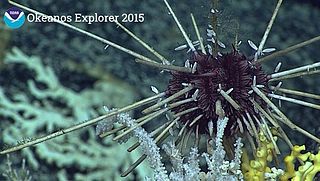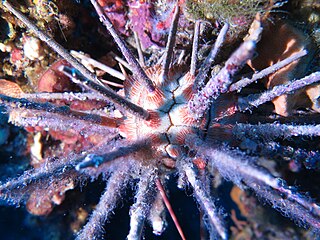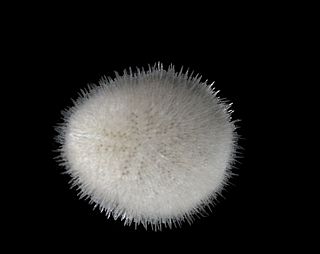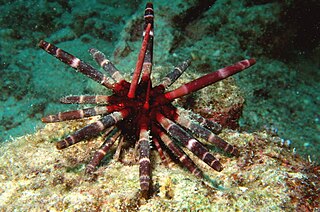
Cidaris is a genus of pencil sea urchins.

The Echinothurioida are an order of sea urchins in the class Echinoidea. Echinothurioids are distinguished from other sea urchins by the combination of a flexible test and hollow spines. The membrane around the mouth contains only simple plates, in contrast to the more complex mouth parts of their close relatives, the Diadematoida. They are nearly all deepsea dwellers.

Cidaridae is a family of sea urchins in the order Cidaroida.

Spatangus is a genus of heart urchins in the Spatangidae family. The genus is synonymous with the previously recognised genera Prospatangus Lambert, 1902 and Spatagus. There are nine recognised species. The type species is Spatangus purpureus Müller, 1776 by subsequent designation.

Clypeaster, common name "cake urchins" or "sea biscuits", is a genus of echinoderms belonging to the family Clypeasteridae.

Eucidaris is a genus of cidaroid sea urchins known as slate pencil urchins. They are characterised by a moderately thick test, a usually monocyclic apical disc, perforate and non-crenulate tubercles and nearly straight ambulacra with horizontal pore pairs. The primary spines are few and widely spaced, stout with blunt flat tips and beaded ornamentation and the secondary spines are short and apressed. They originated in the Miocene and extant members of the genus are found in the tropical Indo-Pacific Ocean, East Pacific, Atlantic Ocean and Caribbean Sea.
Austrocidaris pawsoni is a species of sea urchins of the Family Cidaridae. Their armour is covered with spines. Austrocidaris pawsoni was first scientifically described in 1974 by McKnight.

The Echinothuriidae are a family of sea urchins in the order Echinothurioida. Due to their soft skeletons, most are called "leather urchins", but species in the genus Asthenosoma are also known as "fire urchins" due to their bright colors and painful, venomous sting.

Araeosoma is a genus of deep-sea sea urchins in the family Echinothuriidae.

Histocidaris is a genus of sea urchins in the family Histocidaridae. Some species are known from the fossil record.

Notocrinidae is a monotypic family of crinoids, the only genus being Notocrinus, which contains two species, both endemic to the seas around Antarctica.

The pourtalesiids (Pourtalesiidae) are a family of irregular sea urchins that live in the deep sea. They are secondarily bilateral-symmetrical and like other representatives of the taxon Holasteroida they lack the lantern of Aristotle, which is typical for many other sea urchins. The genus Pourtalesia was named after Louis-François de Pourtalès who first collected these animals while dredging at a depth of 600 m. The family is known already from the Upper Cretaceous (Maastrichtian) and is distributed worldwide.

Aspidodiadema is a genus of echinoderms belonging to the family Aspidodiadematidae. The species of this genus are found in the Indo-Pacific and Caribbean.

Fibularia is a genus of echinoderms belonging to the family Fibulariidae. The genus has almost a cosmopolitan distribution.

Stylocidaris is a genus of echinoderms belonging to the family Cidaridae.
Brissopsis is a genus of echinoderms belonging to the family Brissidae.
Amphipneustes is a genus of echinoderms belonging to the order Spatangoida.

Echinocyamus is a genus of echinoderms belonging to the family Fibulariidae.

Phyllacanthus is a genus of echinoderms belonging to the family Cidaridae.

Notocidaris is a genus of echinoderms belonging to the family Ctenocidaridae.















